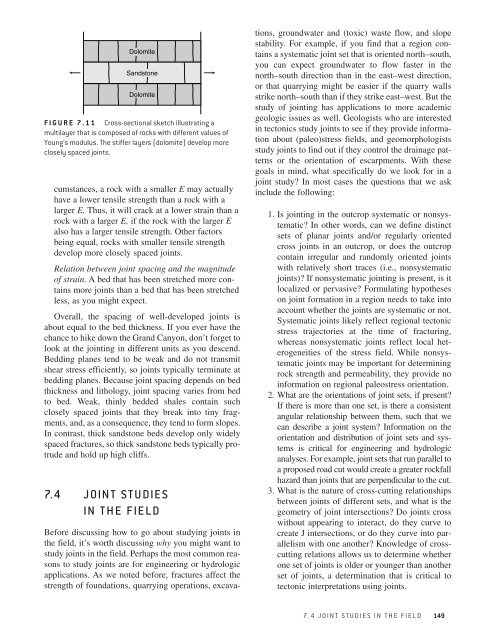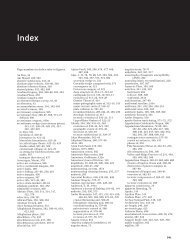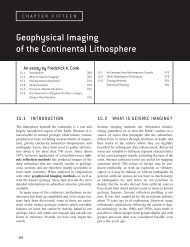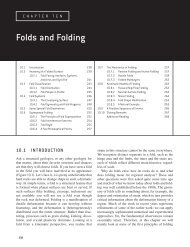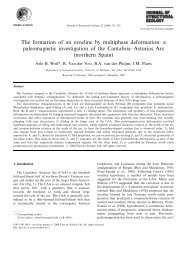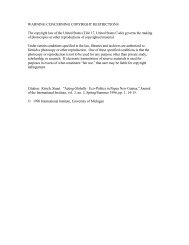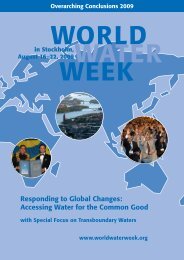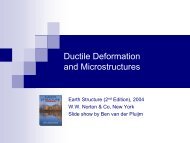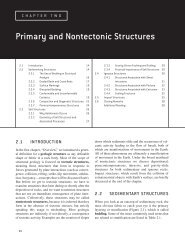2917-CH07.pdf 11/20/03 5:10 PM Page 149DolomiteS<strong>and</strong>stoneDolomiteFIGURE 7.11 Cross-sectional sketch illustrating amultilayer that is composed of rocks with different values ofYoung’s modulus. The stiffer layers (dolomite) develop moreclosely spaced joints.cumstances, a rock with a smaller E may actuallyhave a lower tensile strength than a rock with alarger E. Thus, it will crack at a lower strain than arock with a larger E, if the rock with the larger Ealso has a larger tensile strength. Other factorsbeing equal, rocks with smaller tensile strengthdevelop more closely spaced joints.Relation between joint spacing <strong>and</strong> the magnitudeof strain. A bed that has been stretched more containsmore joints than a bed that has been stretchedless, as you might expect.Overall, the spacing of well-developed joints isabout equal to the bed thickness. If you ever have thechance to hike down the Gr<strong>and</strong> Canyon, don’t forget tolook at the jointing in different units as you descend.Bedding planes tend to be weak <strong>and</strong> do not transmitshear stress efficiently, so joints typically terminate atbedding planes. Because joint spacing depends on bedthickness <strong>and</strong> lithology, joint spacing varies from bedto bed. Weak, thinly bedded shales contain suchclosely spaced joints that they break into tiny fragments,<strong>and</strong>, as a consequence, they tend to form slopes.In contrast, thick s<strong>and</strong>stone beds develop only widelyspaced fractures, so thick s<strong>and</strong>stone beds typically protrude<strong>and</strong> hold up high cliffs.7.4 JOINT STUDIESIN THE FIELDBefore discussing how to go about studying joints inthe field, it’s worth discussing why you might want tostudy joints in the field. Perhaps the most common reasonsto study joints are for engineering or hydrologicapplications. As we noted before, fractures affect thestrength of foundations, quarrying operations, excavations,groundwater <strong>and</strong> (toxic) waste flow, <strong>and</strong> slopestability. For example, if you find that a region containsa systematic joint set that is oriented north–south,you can expect groundwater to flow faster in thenorth–south direction than in the east–west direction,or that quarrying might be easier if the quarry wallsstrike north–south than if they strike east–west. But thestudy of jointing has applications to more academicgeologic issues as well. Geologists who are interestedin tectonics study joints to see if they provide informationabout (paleo)stress fields, <strong>and</strong> geomorphologistsstudy joints to find out if they control the drainage patternsor the orientation of escarpments. With thesegoals in mind, what specifically do we look for in ajoint study? In most cases the questions that we askinclude the following:1. Is jointing in the outcrop systematic or nonsystematic?In other words, can we define distinctsets of planar joints <strong>and</strong>/or regularly orientedcross joints in an outcrop, or does the outcropcontain irregular <strong>and</strong> r<strong>and</strong>omly oriented jointswith relatively short traces (i.e., nonsystematicjoints)? If nonsystematic jointing is present, is itlocalized or pervasive? Formulating hypotheseson joint formation in a region needs to take intoaccount whether the joints are systematic or not.Systematic joints likely reflect regional tectonicstress trajectories at the time of fracturing,whereas nonsystematic joints reflect local heterogeneitiesof the stress field. While nonsystematicjoints may be important for determiningrock strength <strong>and</strong> permeability, they provide noinformation on regional paleostress orientation.2. What are the orientations of joint sets, if present?If there is more than one set, is there a consistentangular relationship between them, such that wecan describe a joint system? Information on theorientation <strong>and</strong> distribution of joint sets <strong>and</strong> systemsis critical for engineering <strong>and</strong> hydrologicanalyses. For example, joint sets that run parallel toa proposed road cut would create a greater rockfallhazard than joints that are perpendicular to the cut.3. What is the nature of cross-cutting relationshipsbetween joints of different sets, <strong>and</strong> what is thegeometry of joint intersections? Do joints crosswithout appearing to interact, do they curve tocreate J intersections, or do they curve into parallelismwith one another? Knowledge of crosscuttingrelations allows us to determine whetherone set of joints is older or younger than anotherset of joints, a determination that is critical totectonic interpretations using joints.7.4 JOINT STUDIES IN THE FIELD149
2917-CH07.pdf 11/20/03 5:10 PM Page 1504. What is the surface morphology of the joints? Isplumose structure visible on joint surfaces, <strong>and</strong> ifso, what types of plumes (wavy or straight) arevisible? Are numerous arrest lines clearly evidenton the joint surface? The presence of plumosestructure is taken as proof that a joint propagatedas a Mode I fracture, <strong>and</strong> the geometry of theplume provides clues as to the way in which thejoint propagated (e.g., in a single pulse, or in severaldistinct pulses). If a joint surface containsnumerous origins, it probably initiated at differenttimes along its length. <strong>Joints</strong> whose surfacescontain many arrest lines probably propagated inincrements. Later we will see that starts <strong>and</strong> stopsof a fracture may indicate that growth was controlledby fluctuating fluid pressure in the rock.Are there other structural features superimposedon joints (e.g., stylolitic pits or slip lineations)? Ifjoints display surface features other than plumosestructure, the features indicate post–joint formationstrain. Stylolitic pitting on a joint indicatescompression <strong>and</strong> resulting pressure solution (seeChapter 9) across the joint, <strong>and</strong> slip lineationssuggest that the joint was reactivated as a faultlater in its history.5. What are the dimensions of joints? In otherwords, are the trace lengths of joints measured incentimeters or hundreds of meters? The effect thatjointing has on rock strength <strong>and</strong> rock permeabilityover a region is significantly affected by thedimensions of the joints. For example, the presenceof large throughgoing joints that parallel anescarpment contribute to the hazard of escarpmentcollapse more than will short nonsystematicjoints. Tectonic geologists commonly focus attentionon interpretation of large joints, on theassumption that these reflect regional tectonicstress conditions, which are of broad interest.6. What is the spacing <strong>and</strong> joint density in outcrop?By joint spacing, we mean the average distancebetween regularly spaced joints. Information onjoint spacing provides insight into the mechanicalproperties of rock layers <strong>and</strong> their fracturepermeability. By joint density, we mean, in twodimensions, what is the trace length of joints perunit area of outcrop, or in three dimensions,what is the area of joints per unit volume of outcrop?Joint density depends both on the length ofthe joints <strong>and</strong> on their spacing. Information onjoint density helps define the fracture-relatedporosity <strong>and</strong> permeability of a rock body.7. How is the distribution of joints affected bylithology? In sedimentary rocks, do individualjoints cut across a single bed, or do they cut acrossmany beds, or even through the entire outcrop <strong>and</strong>beyond? In what way is joint spacing affected bybed composition? In the igneous rocks <strong>and</strong> theircontact zones, is the joint spacing or style (bothwithin an igneous body <strong>and</strong> in the country rockthat was intruded) controlled by the proximity ofthe joint to contact? Information about the relationshipbetween jointing <strong>and</strong> lithology can berelated to physical characteristics such as Young’smodulus (E ), <strong>and</strong> can help determine variationsin fracture permeability as a function of positionin a stratigraphic sequence. Information on therelationship between jointing <strong>and</strong> lithology mayalso give insight into the cause of joint formation.8. Are joints connected to one another or are theyisolated? The connectivity of joints is critical toa determination of whether they could provide apermeable network through which fluids (forexample, contaminated groundwater or petroleum)could flow.9. How are joints related to other structures <strong>and</strong>fabrics? Are joints parallel to tectonic foliations?Are joints geometrically related to folds? Arejoints reoriented by folding, or do they cutacross the folds? Is there a relationship betweenjoint orientation <strong>and</strong> measured contemporarystresses? Is the spacing or style of joints relatedto the proximity of faults? Information on therelation of joints to other structures providesinsight into the tectonic conditions in whichjoints form <strong>and</strong> the timing of joint formationwith respect to the formation of other structuresin a region.7.4.1 Dealing with Field Dataabout <strong>Joints</strong>There are basically two ways to carry out a field studyof joint orientation, spacing, <strong>and</strong> intensity. In the inventorymethod, you define a representative region <strong>and</strong>measure all joints that occur within that region. Forexample, you draw a circle or square on the outcrop <strong>and</strong>measure all joints that occur within its area, or youcould draw a line across the outcrop <strong>and</strong> measure alljoints that cross that line (Figure 7.12). The inventorymethod is necessary if you need to determine fracturedensity in a body of rock, or provide statistics on jointdata. Mathematical procedures for determining jointdensity in three dimensions from measurements on twodimensional surfaces are available, but are beyond thescope of this book. You can use the inventory methodfor either systematic or nonsystematic joints.150 JOINTS AND VEINS


